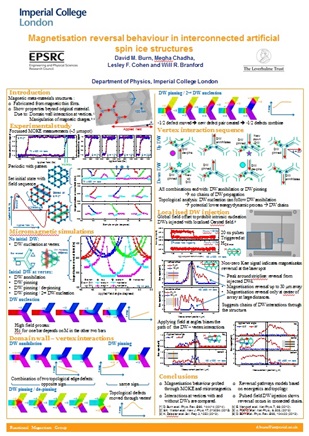
Magnetisation reversal behaviour in interconnected artificial spin ice structures
D.M. Burn, M. Chadha, L.F. Cohen and W.R. Branford
Advances in Modern Magnetic Materials Oxfordshire Jun 2015
Magnetic meta-materials exhibit interesting and complex magnetisation behaviour which originates from nanoscale patterning in addition to the intrinsic properties of the magnetic material. Artificial spin ice is one such example where magnetic nanowires are arranged in a kagome geometry connected by nanowire vertices. The nucleation and propagation of magnetic domain walls (DWs) is the predominant magnetisation reversal process for magnetic nanowires. However, additional complexities in interconnected systems arise due to DW interactions at the vertices[1,2] and the flow of magnetic charge throughout system[3]. These features are governed by the topological nature of the DWs and the artificial geometrical structuring in the material.
In this work, spatially resolved magnetisation reversal behaviour in a kagome artificial spin ice structure is investigated through focussed MOKE magnetometry. The nucleation and propagation of magnetic DWs is observed when a field is applied to the system. Varying the applied field direction relative to symmetry axes in the patterning biases particular sub-lattice directions giving physical insight into the DW propagation and vertex interactions taking place. Additional localised pulsed-field injection techniques[4] allow the DW propagation behaviour to be explored at fields below the intrinsic nucleation field of the system. This allows further characterisation of the DW – vertex interaction and gives control over the DW nucleation location.
This research builds on our understanding of complex interconnected magnetic systems and opens pathways to further explore the manipulation of magnetic charges[5] and their use in potential technological applications.
[1] D. Burn et.al. Phys. Rev. B 90, 144414 (2014)
[2] S.K. Walton et.al. New J. Phys. 17, 013054 (2015)
[3] K. Zeissler et.al. Sci. Rep. 3, 1252 (2013).
[4] D. Burn et.al. Phys. Rev. B 88, 104422 (2013)
[5] E. Mengotti et.al. Nat. Phys. 7, 68 (2010)
We acknowledge Leverhulme Trust grant RPG_2012-692 and UK EPSRC grant EP/G004765/1 for funding.